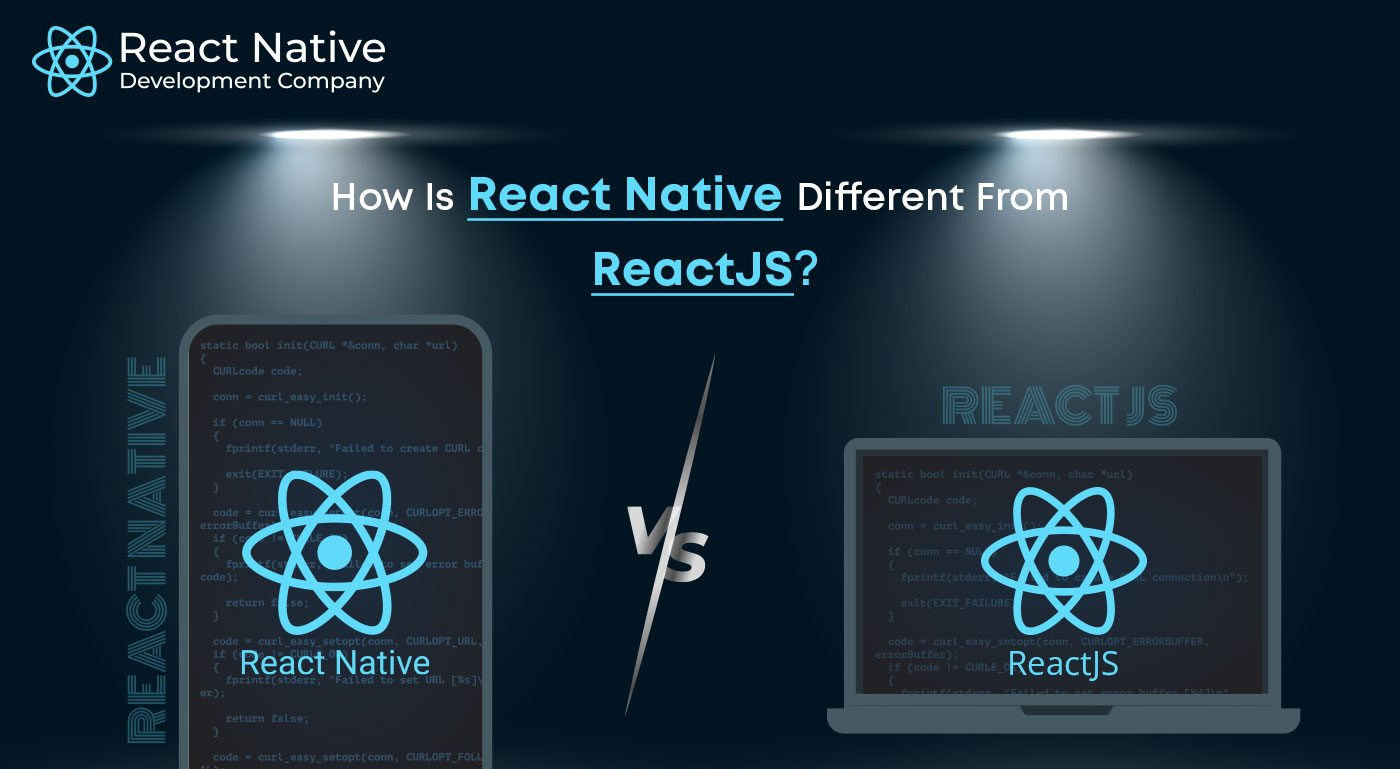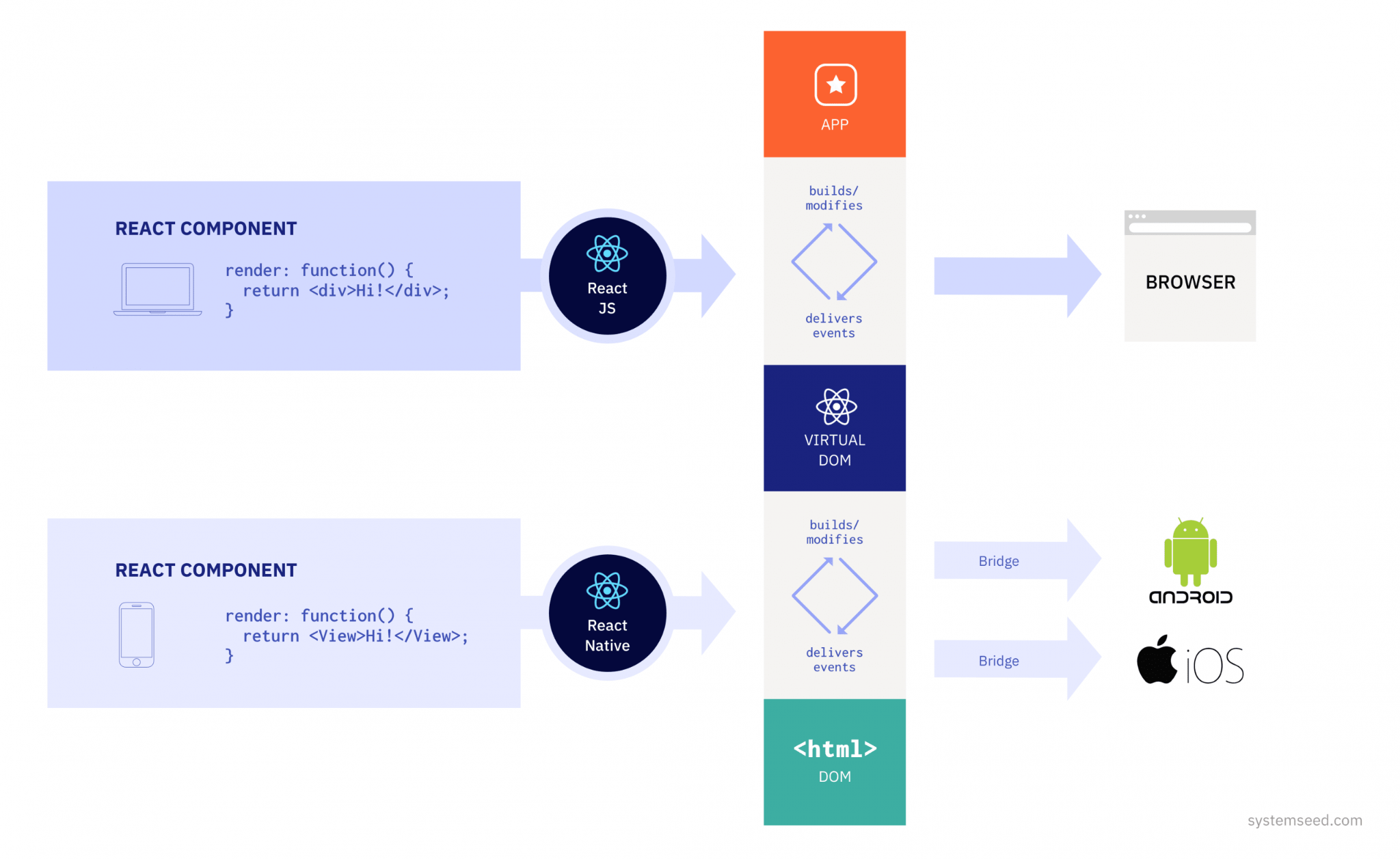
How Is React Native Different From ReactJS?
ReactJS and React Native currently power some of the most popular mobile apps and websites. But, often, we conclude and think both platforms are the same.
ReactJS was first developed internally at Facebook in 2011 to resolve problems with constant updates and changes. In 2012, Instagram was acquired by Facebook, following which React Native was developed to overcome the shortcomings of ReactJS at the time. Since then, they have had parallel development.
With this, the world of developers witnessed the emergence of two of the most powerful technologies — ReactJS and React Native, but both are different.
ReactJS vs. React Native is an intriguing comparison and makes developers think carefully about their usefulness and application in developing responsive web apps, mobile app websites, and more.
Let’s have a look at some of the key features and differences between React JS and React Native.
What Are The Unique Features of React JS?
ReactJS is a JavaScript library used by various projects to create the user interface of web pages. Here are some key features that make it favorable to different developers worldwide.
1. Server-side rendering and SEO
Because ReactJS supports server-side rendering, it increases the SEO of a webpage/app and attracts more organic traffic for its excellent user experience. When a Google bot visits a server that has already rendered content and images, the indexing and caching of content becomes faster.
The fast speed also gives tremendous insight into the overall SEO strategy of the website. Moreover, if the Google bot indexes the content directly on the server side, the page load time decreases. This quick visibility of web pages provides end users with a better experience, hence a win-win situation.
2. Fast Development of Applications and Websites
One of the selling points of ReactJS is its ability to develop high-speed applications and websites. ReactJS creates an in-memory data structure cache that computes the resulting differences, then transparently updates the DOM displayed by the browser.
The programmer writes the code as if each modification displays the entire page when in reality, only the modified sub-components are displayed. This gives ReactJS an advantage over other mobile app development platforms because speed is one of the essential factors in building a successful mobile app.
This fast development extends even to modifying or refactoring existing applications. Further, ReactJS introduced the concept of component-based architecture, which improves the reusability of components and thus saves a lot of time. This component-based architecture takes individual elements of a more extensive user interface and converts them into an independent, self-contained microsystem.
3. Community Support and Third-Party Tools
ReactJS has a massive community of Android and iOS app developers who are known to build a react native exosystem with many tools, component libraries, IDEs, code editor extensions, web browsers, and more.
The availability of a wide range of third-party tools and extensions opens up a new dimension of innovation and saves time and resources. Community innovation makes ReactJS one of the most popular options for developing react native apps and innovative websites.
What Are The Unique Features of React Native?
React Native is a cross-platform mobile framework for building apps and websites. Let’s look at some unique features that make it appealing for any react native app development company to choose React for app development over other platforms and frameworks. Feel free to contact us for React Native App Development services.
1. Easy to make apps using only JavaScript
It’s pretty easy for a front-end developer to understand the technology, and all they need to know is
- JavaScript (especially Reactjs)
- Platform APIs
- Some native UI elements
- Any specific design patterns to the platform.
This simple usage and learning curve allows non-programmers to create applications without much effort. Even front-end web developers can quickly build apps using React Native since most of React Native’s code is in JavaScript.
As a result, apps and websites are being created in a completely different way today. So all you need is an idea and a plan to make this idea a reality.
2. Easy Cross-platform development
One of the most significant advantages of building apps and websites with React Native is it allows you to build codes depending upon the platform, which the framework auto-detects; hence, you find the correct code.
React native builds for native app components allow the programmer to create mobile apps that can run on different platforms like Windows, Android, and iOS using JavaScript. Additionally, Reactjs is used to build components under React Native, and React Native implements Reactjs under their framework.
3. Automatic Reloading in Mobile Applications
Reactjs supports hot reload functionality, which gives developers the freedom to reload a mobile application automatically. This makes the development process fast and saves time. To offer an extremely smooth experience, there are several Component UI libraries available.
Having common UI libraries, such as Expo, Native Base, Shoutem, etc., can save you time building them from scratch. As a result, you can focus more on innovation and ideas rather than building all the libraries from scratch.
Read also: How many types of navigation in react native
What Are The Key Differences Between React JS and React Native?

Below is a detailed list of differences between React JS and React Native.
| React JS | React Native |
| ReactJS is a JavaScript library used by several projects to create the UI for web pages. | React Native is an entire cross-platform mobile framework by itself used for developing native mobile applications. |
| ReactJS is primarily used for web browsers; as a result, you can use it across all platforms without needing to customize it for them. | React Native is best for native application development, and despite Facebook’s best efforts, it still takes considerable effort to optimizing for all platforms. |
| ReactJS uses HTML tags to render its user interface. | React Native uses JSX to render its user interface. |
| ReactJS uses CSS for styling, and it can also have animations using CSS. | React Native uses JSON for styling in the form of a Stylesheet object and for animations, it uses an animated API. |
| ReactJS uses VirtualDOM for easy rendering of DOM elements. | React Native relies on native APIs for most of its rendering. |
| ReactJS uses the React router, which enables users to navigate web pages. | React Native has a Navigator library to let users navigate different screens. |
| ReactJS has support for third-party packages but no support for native libraries. | React Native has no support for native libraries nor any third-party package support. |
| ReactJS is considered more secure because its use is limited to browsers. | React Native is comparatively less secure since it relies on the basic security features of the native system, which may vary. |
When To Use React JS and When to Use React Native:
ReactJS is popularly used to develop dynamic user interfaces for websites and applications. At the same time, React Native is used to creating native mobile apps entirely. Users of these platforms include companies such as Facebook, Netflix, Medium, Udemy, Uber Eats, Tesla, etc.
What Are The Key Limitations?
React Native and React JS platforms have their limitations, so let’s look at them.
Limitations of Reactjs
- Learning Reactjs can take much longer than React Native. This means the learning curve for Reactjs is steep, which can be a problem for new developers trying to build an app with Reactjs.
- While Reactjs supports many third-party external libraries, there are very few native libraries for Reactjs. It is often necessary to download other libraries compatible with ReactJS.
This increases project development costs and adds delays. For example, suppose the developer is using a high-performing specific framework for UI. In that case, they must add other components of that framework with React even if they are not using it.
Limitations Of Using React Native
- Although JavaScript makes React Native easy to learn and develop, it can also lead to various other problems.
- React Native is a framework where programmers can get markup like HTML, stylesheets like CSS, and code from JavaScript. This loose coupling presents many challenges that can cause logical conflicts, which is unlikely with Swift or Java.
- Gadgets and devices also take longer to initialize because of JavaScript threads.
- The lack of native iOS and Android libraries and dependency on external third-party libraries can slow down the development process for React Native.
Because of this, the developers need to find workarounds for them or develop their solutions. If specific functions do not exist in React Native, developers must write the native modules in another language or framework. This can increase overhead single codebase development time and costs.
Licensing and Patent Issues
This is a common problem in ReactJS and React Native. They both have several licensing and patent issues and will likely remain so.
According to their license terms, if a developer uses these open-source platforms for purposes that Facebook does not like, they have the right to block that developer from using them.
This has affected both Reactjs and React Native developers as their applications developed on these platforms can be terminated at any time.
Conclusion
Reactjs and React Native are essential frameworks for website and application development. They are gaining momentum daily with their flexible, cutting-edge features and evolving library ecosystem.
To make it easy to remember:
- React Native is the entire framework
- ReactJS is a JavaScript library
ReactJS is the core of React Native applications and makes it possible to build feature-rich apps with complex calculations. React Native is great for adding a native touch to your app.
All technologies have their uses and limitations, and developers should choose the one that best React Native development services that suits their specific needs.
